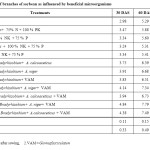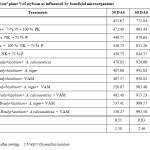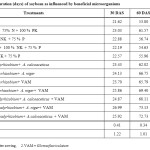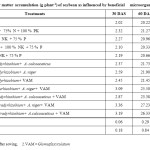Introduction
The soybean is a species of legume crop, native to East Asia, it is popularly known as miracle crop, introduced to India during mid sixties. It is also called as ‘Golden bean’ and it is the second largest oilseed crop in India after groundnut and is being grown in varied agro-climatic conditions. In recent past it has emerged as one of the important commercial crops in many countries. The commercial cultivation of soybean has been widely adopted both in Northern and Southern India mainly in the states of Madhya Pradesh, Maharashtra, Rajasthan, Andhra Pradesh, Karnataka, Chhattisgarh, Uttar Pradesh and Tamil Nadu. In India, the area under soybean cultivation is to an extent of 96.23 lakh hectares with a production of 108.28 lakh tones having a productivity of 1,124 kg ha-1 (Anon., 2011). In Karnataka, it is being grown in an area of 1.80 lakh hectares with a production of 1.84 lakh tons with an average yield of 1,025 kg ha-1 (Anon., 2011). Many popular varieties of soybean have been developed for commercial cultivation which is mainly of grain type. However, very recently the vegetable types of soybean have been introduced from AVRDC, Taiwan. They are rich source of carbohydrates and fiber.
Rhizobium-legume association has got significant importance in the scenario of Biological nitrogen fixation (BNF) as it contributes nearly 100 to 300Kg nitrogen per ha. in one season. Bradyrhizobium forms symbiotic association with soybean to fix atmospheric nitrogen and in turn it gets energy from the host plant. However, the symbiotic relation is governed by many physico-chemical properties of soil like pH, EC, CEC, nitrogen and P levels. It is reported that the effective symbiosis has resulted in increasing the grain yield to an extent of 50% in N deficient soils (Subbarao, 1977).
The concept of active management of rhizosphere population of legume has advanced towards co-inoculation of Rhozobium / Bradyrhozobium strains with plant growth promoting rhizobacteria. It is an effort to shift microbiological equilibrium in favour of increased plant growth promotion, nutrient uptake crop yield and protection from pest and diseases.
Material and Methods
Effect of beneficial microorganisms on growth and total dry matter of Soybean (Glycine max (L.) Merrill) under field conditions in farmer field at Gouribidanur during kharif 2012. The experiment was laid out randomized completely block design with twelve treatments and three replication.
The experimental area was ploughed twice and harrowed to bring the soil to a fine tilth. The FYM was applied (10 ha-1) 15 days prior to sowing of seeds. The experimental area was divided into small experimental plots having a dimension of 3 m X 1.5 m with 30 cm bunds between the plots. The plots of above dimension were proposed to accommodate 12 treatments and 3 replications. Well decomposed farmyard manure was applied to experimental plots two weeks before sowing and mixed thoroughly. The entire quantity of nitrogen, phosphorus and potassium were applied as basal dose at the time of sowing in the form of urea, single super phosphate and muriate of potash. The fertilizer mixture was applied deep in the line and mixed thoroughly with the soil.
Two hundred gram of mixed inoculum of equal proportion of Bradyrhizobiumjaponicum, Aspergillusniger(PSB), Acinetobactercalcoaceticuswere mixed with the soybean seeds using sticky solution shade dried and dibbled the seeds.
The furrow was opened at a row spacing of 30 cm and the treated seeds were placed at 10 cm distance within the rows to a depth of 5 cm and later soil was covered. After germination of seeds, thinning, weeding and plant protection measures were taken and then periodically an observation was recorded.
Leaf area duration was worked out as per the formula given by Power et al. (1967).

Where,
LAD = Leaf area duration in days
LAI1 = Leaf area index at first stage
LAI2 = Leaf area index at second stage
t2 – t1 = Time interval between first and second stages
Results
The data on plant height recorded at 30, 60 days after sowing and at harvest as influenced by interactive effect of beneficial microorganisms on growth and yield of soybean under microcosm conditions. The application of 100 % NPK + Bradyrhizobium + Aspergillusniger + VAM (T11) recorded highest in branches (4.84, 7.79 and 9.76 cm respectively). The lowest plant height (2.98, 5.29 and 6.36 cm respectively) was recorded in the treatment of FYM alone (T1) are presented in Table 1.
 |
Table 1: Number of branches of soybean as influenced by beneficial microorganisms. |
The data with respect to leaf area at 30, 60 days after sowing and at harvest stage was recorded more in the application of 100 % NPK + Bradyrhizobium + Aspergillusniger + VAM (T11) is (537.41, 999.57 and 1211.94 cm2 respectively) and lowest number were recorded in the FYM alone (432.67, 772.04 and 973.51 cm2 respectively) are presented in Table 2.
 |
Table 2: Leaf area (cm2 plant-1) of soybean as influenced by beneficial microorganisms. |
The leaf area duration at 30, 60 days after sowing and at harvest (26.99, 73.13 and 30.60 days respectively) was recorded in plants treated with 100 % NPK + Bradyrhizobium + Aspergillusniger + VAM (T11)as influenced by beneficial microorganisms are presented in Table 3.
 |
Table 3: Leaf area duration (days) of soybean as influenced by beneficial microorganisms. Click here to View table |
Total dry matter at was highest recorded at 30, 60 days after sowing and at harvest (3.36, 27.23 and 32.73 g plant-1 respectively) compare to FYM alone (T1) (2.02, 20.22 and 22.63 g plant-1 respectively) are presented Table 4.
 |
Table 4: Total dry matter accumulation (g plant-1) of soybean as influenced by beneficial microorganisms. Click here to View table |
Discussion
Rhizobium is a symbiotic N fixer in pulses and oil seed crops and is known to produce growth promoting substances like IAA, gibberellins and cytokinins etc., which help in enhancing the plant growth and yield. Many research studies have showed that dual or triple microbial inoculation is highly beneficial to crop growth in obtaining higher crop yield (Iraj et al., 2009). In this study combined application of Bradyrhizobium, Aspergillusniger and VAM with 100 % NPK to soybean has resulted in enhanced plant growth attributes as compared to individual inoculation.
More number of branches were obtained in the treatment of 100 % NPK + Bradyrhizobium + Aspergillusniger + VAM (T11) at all the growth stages of plant growth viz., 30, 60 DAS and at harvest stage (9.76). These results are in accordance with the findings of Nagar and Dadheech, (2002) who observed such increased number of branches in soybean when the crop was dually inoculated with Bradyrhizobiumand PSB.
In the experiment, treatments exhibited differences in dry matter accumulation from 30 DAS to harvest stage. At harvest significantly higher total dry matter accumulation (32.73 g plant-1) was recorded in the treatment of 100 % NPK + Bradyrhizobium + Aspergillusniger + VAM (T11). The production of more number of trifoliate leaves, more number of branches and increased plant height were greatly influenced the dry matter accumulation per plant. Lowest dry matter production was recorded with application of FYM alone (T1). Such increased dry matter accumulation due to combined application of microbial inoculants was also earlier reported in other crops like blackgram and greengram (Kalita et al., 2006).
Application of biofertilizers has resulted in improved nodulation in plant roots and resulted in supplying higher amount of nitrogen for growth and yield attributes which inturnhelped to realize higher growth parameter and dry matter of soybean. Similar observations were earlier reported by Dubeyet al., (1995) and Thenuaet al., (2010). In addition to this, combination of Rhizobium, PSB and VAM has resulted in cumulative effects such as supply of N and P to the crop along with production of growth promoting substances like auxin, gibberlins and cytokinins. These results are in agreement with the findings of Singh (2005), Tomar (2011) Nagaraju and Mohankumar (2010).
Conclusion
The results indicated that the growth parameters of soybean viz., Number of branches, leaf area, leaf duration and total dry matter production was highest due to application of consortia of microorganisms compare to sole application. So according to this findings application of Consortia to be needed for better growth and dry matter production of soybean under field conditions.
References
- ANONYMOUS, 2011, Project Director’s Report, AICRP on soybean, DOR, Indore.
- DUBEY, S. K., 1995, Co inoculation of phosphorus solubilizing bacteria with Brady rhizobium japonicum to increase phosphate availability to rainfed soybean on Vertisols. J. Indian Soc. Soil Sci., 46(3):474-476.
- IRAJ ALAHDADI., MASOUMEH TAJIK., HAMID IRAN-NEJAD AND OMID ARMANDPISHEH., 2009, The effect of biofertilizer on soybean seed vigor and field emergence. J. Food. Env.,7(3-4): 420-426.
- KALITA, R., DEKA, A. K. AND AZAD, P., 2006, Evaluation of native Rhizobium from acid soils of Assam on pigeonpea.Legume Res., 29(3): 157-162.
- NAGAR, R. K. AND DADHEECH, R. C., 2002, Response of soybean varieties to Bradyrhizobium under varying nitrogen levels. Haryana J. Agron., 18(1-2) : 170-171.
- NAGARAJU, A. P., AND MOHAN KUMAR, H. K., 2010, Effect of micronutrients and bioinoculants on growth and yield of soybean (Gycine max (L.)). Mysore J. Agric, Sci., 44(2):260-265.
- SINGH, M.S., 2005, Effect of Bradyrhizobium inoculation on growth, nodulation and yield attributes of soybean -A review. Agric. Rev.,26(4): 305–308.
- SUBBAIAH, B. Y. AND ASIJA, G. L., 1956, A rapid procedure for the estimation of available nitrogen in soils. Curr. Sci., 25:259-260.
- SUBBARAO, N. S., 1977, Yield response to Rhizobium inoculation in India. Oxford and IBH publishing Co.pvt.Ltd, pp. 157-158.
- THENUA, O. V. S., KULDEED SINGH AND SHIVAKUMAR, B. G., 2010, Studies on Rhizobium inoculation and potassium levels on the performance of soybean (Glycine max L.). Ann. Agric. Res.,31(1): 1-4.
- TOMAR, R. K. S., 2011, Effect of integration of bio-fertilizers farm yard manure and inorganic fertilizers on productivity of soybean (Glycine max L.) in farmers’ field. J. Oilseeds Res.,28(2): 112-114.
